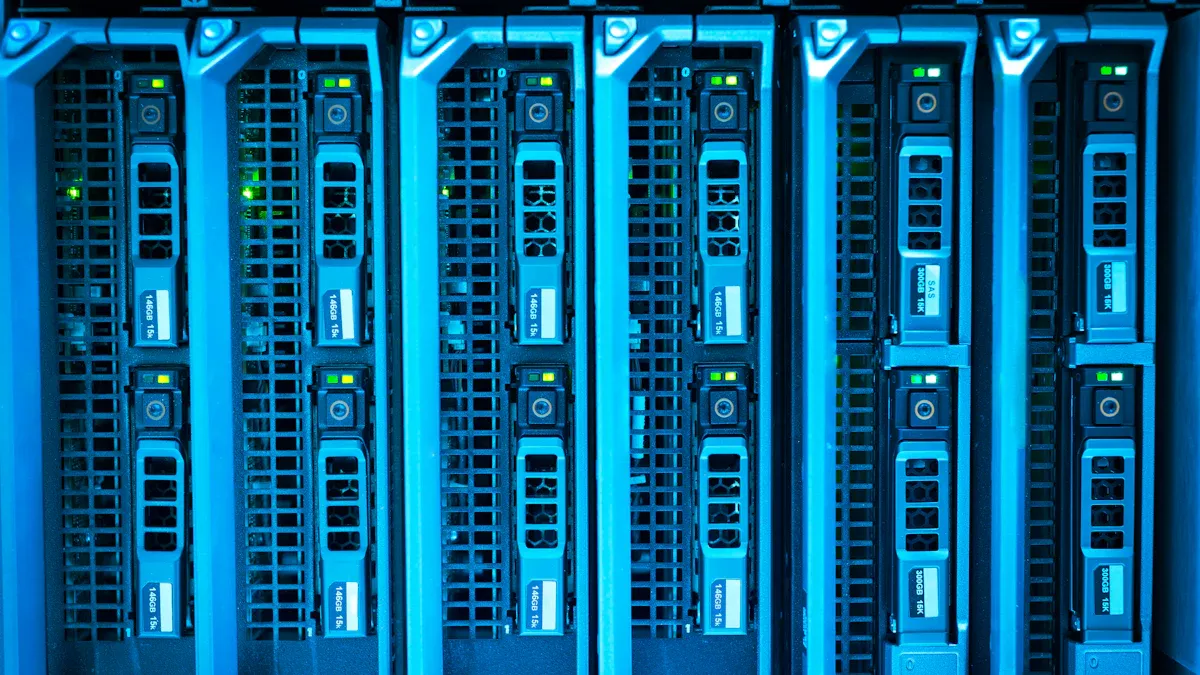
Data centers in Russia face mounting pressure to handle energy demands efficiently. High-density PDUs provide a solution by optimizing power distribution. For instance, rack PDUs over 10kW grew from 18% of global revenue in 2013 to 24.2% by 2017. These tools also support scalable cloud infrastructure, crucial for meeting rising service demands.
Key Takeaways
- High-density PDUs help share power better, saving energy and cutting costs for cloud companies.
- These tools allow data centers to grow and handle more power as the Russian cloud market expands.
- Smart features in high-density PDUs help fix problems early, reducing outages and making systems more reliable.
Unique Challenges for Russian Cloud Providers
Rising Energy Costs and Efficiency Needs
Energy costs in Russia have been steadily increasing, putting pressure on cloud providers to find efficient solutions. Data centers consume vast amounts of electricity, and inefficient power distribution can lead to significant financial losses. High-density PDUs offer a way to optimize energy usage by distributing power more effectively across racks. This not only reduces waste but also helps providers manage their operational costs better. With energy efficiency becoming a priority, adopting advanced power management tools is no longer optional—it’s essential.
Scalability in a Rapidly Growing Cloud Market
The Russian cloud market is expanding at an impressive rate. By the end of 2023, it is expected to grow by at least 40%, driven by increased cloud adoption and government support. Looking ahead, the data center market is projected to grow at a CAGR of 8.4% from 2025 to 2033. This rapid growth demands scalable infrastructure, and high-density PDUs play a critical role in meeting these needs. Their ability to handle higher power demands makes them ideal for large-scale data centers, ensuring seamless scalability as the market evolves.
Managing Remote Data Centers Across Vast Geographies
Russia’s vast geography presents unique challenges for managing remote data centers. While 85% of data centers are concentrated in the European part of the country, regions like Murmansk and Krasnoyarsk offer untapped potential due to their energy resources. High-density PDUs with intelligent features enable remote monitoring and management, making it easier to oversee operations across these distant locations. This capability ensures consistent performance and reduces the need for on-site interventions, saving time and resources.
Benefits of High-Density PDUs for Cloud Providers

Cost Efficiency Through Optimized Power Distribution
High-density PDUs help cloud providers reduce energy costs by optimizing power distribution. They ensure that power is delivered efficiently to each rack, minimizing waste and improving overall energy usage. Metrics like Power Usage Effectiveness (PUE) and ENERGY STAR ratings highlight how these devices enhance energy efficiency. For example:
- PUE measures the ratio of total power consumption to IT equipment power consumption, helping identify inefficiencies.
- ENERGY STAR ratings benchmark energy performance, encouraging better practices.
- Real-time monitoring tools provide insights into power usage, enabling providers to make data-driven decisions.
By adopting high-density PDUs, cloud providers can achieve significant cost savings while maintaining sustainable operations.
Improved Uptime and System Reliability
Reliability is critical for cloud providers, and high-density PDUs play a key role in ensuring uptime. These devices distribute power evenly, reducing the risk of overloads and outages. A comparative analysis shows the impact of integrating high-density PDUs:
| Metric | Before Integration | After Integration | Improvement |
|---|---|---|---|
| Energy Costs | N/A | 20% reduction | 20% reduction |
| Uptime Reliability | N/A | Improved | Enhanced reliability |
This improvement in uptime ensures uninterrupted services, which is essential for customer satisfaction and operational success.
Advanced Remote Monitoring and Management Features
Managing distributed data centers becomes easier with the advanced features of high-density PDUs. These devices offer remote monitoring capabilities, allowing IT teams to oversee operations from anywhere. Key benefits include:
- Real-time tracking of power consumption and network performance.
- Proactive alerts to identify and resolve issues before they escalate.
- Remote configuration and troubleshooting, reducing the need for on-site interventions.
Cloud-based monitoring tools further enhance visibility, helping providers optimize performance across hybrid and private cloud environments. These features not only improve operational efficiency but also save time and resources.
Practical Applications of High-Density PDUs

Addressing Power Distribution in High-Density Environments
Modern data centers are packing more servers into smaller spaces, increasing power demands significantly. IT racks now require 20-30 kW, compared to just 5 kW a few years ago. High-density PDUs are designed to handle these demands efficiently, ensuring consistent power delivery even in dense setups. Their three-phase power distribution capabilities are particularly effective for high-performance computing (HPC) and artificial intelligence (AI) workloads, where uninterrupted power is critical.
Efficient wiring management is another advantage. Smaller, organized wires simplify installation and reduce costs, making high-density PDUs a practical choice for cloud providers. Studies have shown that optimized power distribution can reduce energy consumption by up to 15.5%, while improved cooling strategies enhance system efficiency.
| Study Title | Key Findings | Reduction in Power Consumption |
|---|---|---|
| A Quantitative Comparison of High Efficiency AC vs. DC Power Distribution for Data Centers | Proposed a power load distribution algorithm (PLDA) to optimize energy distribution. | Up to 15.5% |
Supporting Scalable Cloud Infrastructure Expansion
As the Russian cloud market grows, scalability becomes a top priority. High-density PDUs support this expansion by delivering reliable power to larger infrastructures. Their ability to manage higher power loads ensures seamless integration of new servers and equipment. For example, three-phase UPS systems evenly distribute loads, reducing downtime and maintaining consistent power supply during infrastructure upgrades.
Remote control capabilities further enhance scalability. Switched rack PDUs allow IT teams to manage power remotely, streamlining operations and reducing the need for on-site interventions. This feature is especially valuable for cloud providers operating across Russia’s vast geography, where physical access to data centers may be limited.
| Aspect | Details |
|---|---|
| Power Demand Increase | IT racks have increased from 5 kW to 20-30 kW due to denser server packing. |
| Efficiency of Three-Phase Power | Designed to support high-power demands effectively, crucial for AI and HPC workloads. |
| Wiring Management | Smaller, manageable wires reduce installation costs and complexity for high-density setups. |
| Remote Control Capabilities | Switched rPDUs allow for remote power management, enhancing operational efficiency. |
| UPS Systems | Three-phase UPSs manage loads evenly, ensuring consistent power supply and reducing downtime. |
Enabling Proactive Maintenance and Issue Resolution
High-density PDUs come equipped with advanced monitoring features that enable proactive maintenance. Real-time tracking of power usage helps identify inefficiencies and potential issues before they escalate. This approach minimizes downtime and operational disruptions, saving cloud providers both time and money. For instance, a mid-sized data center reduced downtime incidents by 30% and saved $50,000 annually through proactive maintenance.
Energy waste reduction is another benefit. Organizations using high-density PDUs have reported up to 20% less energy waste, thanks to real-time monitoring and intelligent alerts. These features empower IT teams to address problems quickly, ensuring smooth operations and improved system reliability.
| Evidence Type | Description | Impact on Efficiency |
|---|---|---|
| Downtime Reduction | A mid-sized data center reduced downtime incidents by 30%. | Minimizes operational disruptions. |
| Cost Savings | The same center saved $50,000 annually due to reduced downtime. | Direct financial benefit from efficiency. |
| Energy Waste Reduction | Organizations reduced energy waste by up to 20% through real-time monitoring. | Enhances overall energy efficiency. |
High-density PDUs are transforming how Russian cloud providers tackle operational challenges. Their adoption offers several advantages:
- The global rack PDU market is expected to grow from $1.6 billion in 2023 to $2.9 billion by 2032, reflecting their increasing importance.
- Power-related issues caused 44% of data center outages in 2022, emphasizing the need for optimized power management.
- Downtime costs can reach $5600 per minute, making reliable power distribution essential.
These devices also improve uptime and scalability. For instance, ATS PDUs enhance reliability by 25%, while intelligent PDUs reduce energy waste by up to 20%. With features like remote monitoring and surge protection, high-density PDUs ensure operational efficiency and future-proof infrastructure. Russian cloud providers should prioritize their integration to stay competitive.
FAQ
What makes high-density PDUs different from standard PDUs?
High-density PDUs handle higher power loads and offer advanced features like remote monitoring, three-phase power distribution, and better energy efficiency. They’re ideal for modern, high-demand data centers.
Are high-density PDUs suitable for small-scale data centers?
Yes, they work well for small-scale setups too. Their scalability and energy efficiency make them a smart choice for growing infrastructures or limited-space environments.
How do high-density PDUs improve energy efficiency?
They optimize power distribution, reduce energy waste, and provide real-time monitoring. These features help data centers lower operational costs and achieve better sustainability metrics.
Post time: Apr-10-2025

